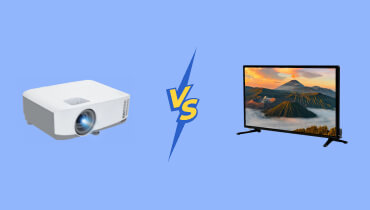NTSC VS PAL: Iconic Players in the Features & Functions
Since the 1950s, a lot has happened in the world, and the problems that these TV standards were created to address in the past are no longer relevant. The resolutions, timings, and other specifications set forth in these video standards are still utilized in contemporary TV sets and displays. Blu-rays, DVDs, and a host of other media are still labeled PAL or NTSC.
In the midst of new technology and modernization, let us travel back in time by reviewing the differences and similarities between PAL vs NTSC as one of the main primary resources of entertainment during the 19th century. Please read this historical review post.

PAGE CONTENT
Part 1. What is NTSC?
The term National Television Standard Committee or NTSC refers to an analog color-encoding video system that was utilized in DVD players and, until recently, in North American television programming. Black-and-white television began to give way to color television in the 1950s, rendering the earlier technical standard outdated. In the meanwhile, U. S. Broadcasting firms were encoding color using a variety of techniques, all of which competed with one another.

Part 2. What is PAL?
Another video mode scheme for analog color television, known as Phase Alternating Line or PAL, is also utilized in DVD and Blu-ray players. The PAL format, which was developed in Germany in the late 1950s, was intended to address some of the shortcomings of NTSC, such as signal instability during bad weather, which was particularly important for broadcasters in Europe. Reversing every other line in a TV broadcast was the new standard for solving this issue and getting rid of mistakes.

Part 3. Differences Between NTSC and PAL
Encoding of Colors
Color adjustment for tint is done manually in NTSC receivers. Off-hue colors stand out more in NTSC because of their higher saturation. Some modifications must be made. PAL automatically controls color. To eliminate hue inaccuracies, color signal phase modification is used. In actuality, PAL eliminates chrominance phase errors.
Image Quality
NTSC offers a resolution of 525 lines. More lines indicate a higher-quality image. As a result, the image quality is worse than with PAL. At 50 cycles per second, PAL lines may terminate. It thus offers twenty-five alternate lines.
Additionally, it generates 25 frames per second, leading to a quicker presentation of images. PAL has 625 total lines of resolution, which is more than NTSC. Therefore, you may argue that PAL has a higher visual quality than NTSC. If you need a high-quality video, you can use a video resolution enhancer to do it.
Frames Per Second
The Frames-per-second or FPS rate, which varies between the two standards, 25 for PAL and 29.97 for NTSC, is another distinction. When it came to NTSC, a 60-Hz home outlet would alternate fully once every 30 FPS or one frame. But when color television became popular, black-and-white televisions could no longer accurately decipher brightness and color signals, leading to absurd visuals on their screens.
In order to solve this issue, a second chrominance signal had to be introduced in between oscillations in the luminance signal. This extra signal was securely disregarded by black-and-white TVs and correctly displayed by color TVs with the use of an adapter. (DVDs not playing on TV?)
Part 4. PAL vs NTSC: Which is Better?
There can be different factors in saying which one is better between PAL and NTSC. Well, in this post, you, the reader, will decide which one is better. We will help you decide by giving you the details of each medium. You can use these as a factor in choosing which one is better. For that, please start seeing this table.
| PAL | VS | NTSC |
| 25 fps | FPS | 29.97 fps |
| 5 MHz | Video Bandwidth | 4.2 MHz |
| 625/60 | Line/Field | 525/60 |
| 5.5 MHz | Audio Carrier | 4.5 MHz |
| 50 Hzx | Horizontal Frequency | 60 Hz |
| 15.625 kHz | Vertical Frequency | 15.734 kHz |
| 4.433618 MHz | Color Subcarrier Frequency | 3.579545 MHz |
Part 5. Bonus: Best Video and Disc Player
At the beginning of this post, we already knew NTSC and PAL are old players that can play our CDs and DVDs whenever we want to play movies or other things. However, with the rise of technology and modernity, the medium must be enhanced and developed to satisfy and improve our life experiences. That ideology must be applicable to using a DVD player nowadays.
In connection with that, this modern-day Vidmore Video Player is a great choice to use in watching our DVDs and CDs with high-quality resolution and smooth playback. More than the visuals, these tools can also offer an incredible audio experience. Indeed, it is an all-in-one video player that makes modern playback accessible to everyone. For that, you can now get rid of these PAL and NTSC and get Vidmore Video Player for free.

Part 6. FAQs about NTSC vs. PAL
Is NTSC or PAL better quality?
NTSC and PAL are video encoding schemes that are utilized in various locations. NTSC often has a higher frame rate but lesser resolution than PAL. The apparent quality difference is subjective and influenced by factors such as display equipment and personal choice. Modern devices frequently accept both formats, which reduces the impact of quality disparities.
Will NTSC play in the US?
Yes, the United States uses the NTSC video standard. If you have an NTSC-compatible device or content, it will play properly in the United States.
Can I play a PAL DVD in the US?
It may be difficult to play a PAL DVD in the United States because most DVD players and televisions are designed for NTSC. However, some newer DVD players and multisystem televisions may accept both NTSC and PAL formats, allowing PAL DVDs to be played. Check your playback device's requirements to guarantee compatibility. Furthermore, region coding on DVDs may present another challenge, as different regions have unique codes. Some players can be adjusted or are region-free to get around these restrictions.
Conclusion
It is incredible to know the facts behind the iconic PAL and NTSC. From the details above, may you have your judgment on what is best for you to use. However, if you think that these two are outdated and you need a large caliber tool in playing your DVD, then we recommend Vidmore Video Player and enjoy every bit of your movie or video.


